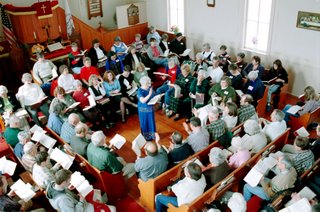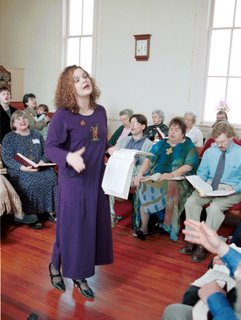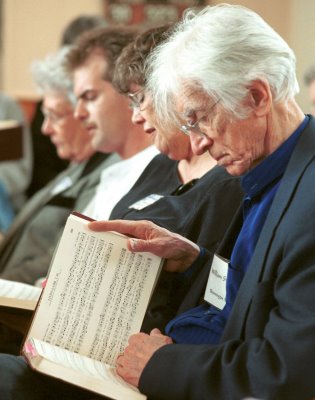 PINCKNEY, Mo.--A stone's throw north of the Missouri River, where Highway 94 crosses a one-lane bridge and wends its way across the rich bottom land toward Jefferson City, shines a white country church against the muted background of late winter.
PINCKNEY, Mo.--A stone's throw north of the Missouri River, where Highway 94 crosses a one-lane bridge and wends its way across the rich bottom land toward Jefferson City, shines a white country church against the muted background of late winter.Here, beneath the peaked roof of the 131-year-old St. John's United Church of Christ, time stood still for an eclectic group of singers who practice an archaic form of music known as Sacred Harp.
"It expresses your feelings about God, about how it feels deep down inside your heart,"explained 48-year-old Alice Moran, who was one of a handful of Joplin-area singers at the two-day convention.
Others, however, said religion isn't necessary.
Gary Gronau, a 57-year-old folk music fan and self-described '60's civil-rights activist from St. Louis, cited the music itself as the biggest draw.
"In this room there are a lot of people who are very strongly religious, and then there are people who are atheists--like me," he said.
 Unlike most forms of music, which are intended for an audience, Sacred Harp is meant to be experienced. Harpers sing primarily for the joy of singing, said Gronau, and he repeated a quote attributed to legendary Georgia singer Hugh McGraw: "I will travel across the country to sing Sacred Harp, but I wouldn't walk across the street to listen to it."
Unlike most forms of music, which are intended for an audience, Sacred Harp is meant to be experienced. Harpers sing primarily for the joy of singing, said Gronau, and he repeated a quote attributed to legendary Georgia singer Hugh McGraw: "I will travel across the country to sing Sacred Harp, but I wouldn't walk across the street to listen to it."
Hollow square
For the uninitiated, the sound can be unpleasant. The lyrics are difficult to understand, unless a printed version is handy, and the seating arrangement of the singers is unlike that of any other kind of performance; unless you're participating, you're looking at their backs.
Members of the congregation sit in what is traditionally called a "hollow square," facing one another, and the music is divided into four parts, from bass to treble, with the melody carried by the tenors.
Song leaders stand in the center of the square and announce songs by calling out their page numbers from the most recent revision of the 1844 book, which stays open on the laps of most. Before they launch into a song, the leader has the group "sing the notes" of the melody while naming the shapes: "fa, sol, la." Pitches are adjusted to meet the needs of the group, so songs may or may not be sung in the keys in which they are written.
The leaders keep time with their hands, turn to coax the best performance from each section, and sometimes scold unruly children at the edge of the group with a well-aimed look. Meanwhile, the singers beat time with their feet, sing as if their lives depended upon it, and often are so swept away by the experience that their faces are portraits of joy.
Near the center of the group, the music not only leaves your ears ringing but can be felt thumping in your chest and abdomen. Veteran harpers tell a tale, perhaps apocryphal, that someone once measured the sound inside the hollow square and came up with a reading of just over 100 decibels--which approaches the level of an average rock concert, at least from a few rows back.
But volume is only one characteristic of Sacred Harp.
Instead of the usual triads found in religious music, the chords are filled with octaves, fourths and fifths. There is also the occasional discordant note, which somehow contributes to the power and also manages to send chills down your spine.
"It's way cathartic," Gronau said.
Primal appeal
Named for an 1844 book that collected the popular ballads and church hymns of the day, the Sacred Harp-style is sometimes called "shape note" because of its primitive system of notation.
 Although the tradtions began in New England, it quickly spread to the Midwest and antebellum South. Singing masters would travel from town to town, give lesson, and largely make their living by the sale of the oblong tune books such as "The Sacred Harp."
Although the tradtions began in New England, it quickly spread to the Midwest and antebellum South. Singing masters would travel from town to town, give lesson, and largely make their living by the sale of the oblong tune books such as "The Sacred Harp."Their method taught musical sight reading by combining solmization, or syllable singing, with a notation system of four shapes that represent intervals instead of absolute pitches: triangle, oval, rectangle and diamond.
The advantage was that students unschooled in tradtitional musical notation could learn to sight-read quickly. Also, in the days long before television took the place of the family hearth or village well, the singing schools were an important social function.
"The singing master often appeared with a blackboard, charts showing tonal steps and their changes with keys, a pointer, pitchpipe, an armful of tune books, a love for music, and an earnest desire to teach people to sing," writes Shirley Bean, an associate professor of music at the University of Missouri-Kansas City, in the introduction to "The Missouri Harmony," a collection of 1820's frontier hymns reprinted recently by the University of Nebraska Press.
"The hopeful scholars brought firewood, slates or lapboards, candles, and an eagerness to learn the art of singing. The candles were sealed to the corners of the slates or boards to supply light. Seating was usually arranged in a semicircle severals rows deep. Instruction commenced with a presentation of the rudiments of music. . .soon the group was given exercises in voice placement."
Although most of the songs are religious in nature, some are ballads or commemorate events contemporary to the tune books. Some are unabashedly patriotic.
The spirits of Washington, Warren, Montgomery / lookdown from the clouds with bright aspect serene, begins a tune called "The American Star," which cites a trio of Revolutionary War heroes. Come, soldier, a tear and a toast to their memory / Rejoicing they'll see us as they once have been.
Other tunes can be described only as somber, even morbid.
Remember, you are hast'ning on / To death's dark, gloomy shade, the young are warned in "New Topia. " Your joys on earth will soon be gone / Your flesh in dust be laid.
"The words are imortant," observed Karen Isbell, a former president and founding member of the St. Louis singing group. "They're from a time when life was brutal. People had a different view of God and religion back then--primal, really stark and stripped down--and frankly, I think that's part of the appeal. Life mattered."
Rediscovery of style
While the music eventually died out in New England and the Midwest, it was passed uncorrupted from generation to generation in Primitive Baptist and other churches in the deep South. When a revival of interest in Sacred Harp music began around 1983 in places like Chicago and St. Louis, it was the Southern harpers who eventually showed the newcomers how to sing it full bore.
"We had been struggling along on our own," said Gronau, another founding member of the St. Louis Shape Note Singers.
At first, the members passed around barely legible photocopies from the original tune books, met in attics and basements, and tried their best to conjure the magic the printed matter only hinted at. Then, it occurred to Gronau to seek out those who had grown up in the tradtion, in much the same way blues fanatics had scoured the Mississippi delta seeking links to Robert Johnson and other masters. The result, Gronau said, was a rediscovery of a style that was "crisp and clean."
Also, Gronau learned, Sacred Harp is nothing short of a subculture based on a sort of musical communion, and bolstered by a tradition of shared meals and old-fashioned sensibilities. Harpers may travel across the state to attend a one-day "singing," or across the counry to attend one of the two-day state conventions like last weekend's 16 Annual Missouri Convention at Pinckney, for which the St. Louis group was host.
One of the new singers was Steven Henness, 28, a postgraduate student at the University of Missouri in Columbia. Henness, who holds a master's degree in rural sociology, had been traveling the state gathering information for a research project on community development when he heard of the upcoming convention. Although he attended because of his academic interest in rural tradtions, he soon found himself in the tenor section, singing from a copy of "The Sacred Harp."
"It was both exhausting and energizing at the same time," Henness said. "Instead of just trying to mechanically hit each note one after the other, I found myself being lost in the rhythm and power of the thing."
Also, Henness, the reason Sacred Harp is growing in popularity may be that it allows individuals "to ground their identities" in a tradition that is bigger and older than themselves. This, he said, is becoming increasingly difficult in a world that keeps changing faster than our forefathers could have imagined.
"I was not raised in this kind of tradition," said Elizabeth Senger, who drove with her family from LaCrosse, Wis., to attend the convention. "I was at a folk festival and I heard this stuff at a distance. I was curious, went to take a look, and somebody put a book in my hand."
For Senger, her faith is part of the experience.
"I find I worship better here than in my home church," she said. "There is a power to this kind of music that you don't find in popular culture. You feel connected to people that lived a hundred or more years ago. This morning, for example, we sang about the death of George Washington."
Another attraction, Senger said, is the democratic nature of the event: Song leaders are male and female, young and old, religious and not.
"You know, you hear people talk a lot about jazz as the only style of music that is native to America," she said. "Well there's this, too."
Popular gospel song has uncertain origin
Of all the songs in the Sacred harp tradition, the most popular is a simple tune called "Amazing Grace." Listed at the top of Page 45 of "The Sacred Harp," an 1844 collection of hymns, the song is titled "New Britain."
Many of the tunes in the collection are named for locations that have little to do with the lyrics, but which may reflect the titles of older melodies to which the words were grafted. The origin of the music for "Amazing Grace," however, is uncertain.
The words were written by John Newton, a former slave ship captain. By his mid-20's Newton was engaged in the horrific trade, in which slaves were packed into ships like cordwood and traded in the New World for sugar and molasses, which were taken back to England.
On May 10, 1748, Newton appealed to God to steer his ship safely through a violent storm. Just when it seemed the ship would sink, Newton uttered a simple request: "Lord, have mercy upon us." Although his prayer was answered, he continued in the slave trade for several more years, but gave it up because of ill health and eventually becme a minister in the Church of England.
At Olney, Newton became friends with the poet John Cowper, who helped him with his services. Together, they resolved to write a new hymn for each weekly service and prayer meeting. One of the hymns that resulted was "Amazing Grace," and it was first published in 1779.
Newton wrote several hundred other hymns and kept extensive journals, which have provided many modern historians with a glimpse of the 18th century slave trade. He died Dec. 21, 1807, in London, at the age of 84. Ironically, the "wretch" who once could see had gone blind.
The tune "New Britain" first appeared in a book published in 1829 in Cincinnati, Ohio. Since that time, more than 24 different tues have been published for "Amazing Grace," although many are variations of the one found in "The Sacred Harp."
The first stanza found in many contemporary hymnals, which begins "When we've been there ten thousand years," was not penned by Newton. It first appeared in 1909 and appears to be from an anonymous English folk hymn.
Newton's final stanza:
The earth shall soon dissolve like,
The sun forbear to shine;
But God, who call'd me here below,
Will be forever mine.
Photo captions, from top to bottom:
The hollow square as seen from the balcony of St. John's United Church of Christ in Pinckney, Mo. on March 10, 2001. This was the sixteenth annual Missouri State Scared Harp Singing Convention. From the left, basses, tenors, trebles and in front of the altar, altos.
Cassie Franklin, Henegar, Ala., leads the class in song 222-Ocean on Sunday, March 11, 2001 during the sixteenth annual Missouri State Sacred Harp Singing Convention in Pinckney, Mo. at the St. John's United Church of Christ. She sang both a solo unaccompanied song, Lady Margaret, and as a member of the Sacred Harp Singers for the soundtrack of the movie Cold Mountain released Dec. 25, 2003.
William Shetter, Bloomington, Ind., sings song 308-Parting Friends (Second) on Saturday, March 10, 2001 during the sixteenth annual Missouri State Sacred Harp Singing Convention at the St. John's United Church of Christ in Pinckney, Mo.